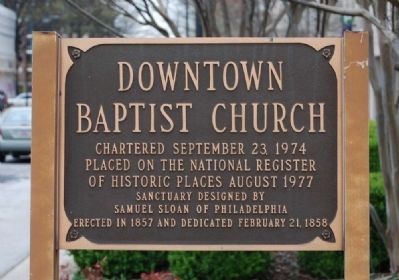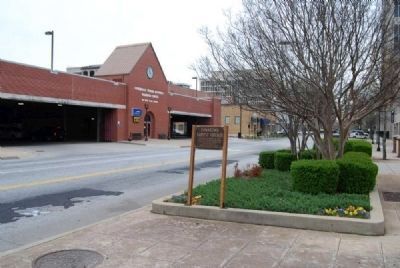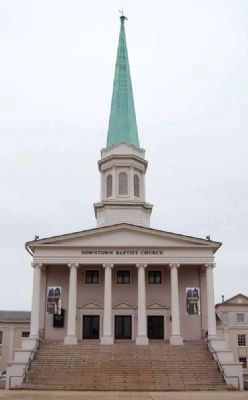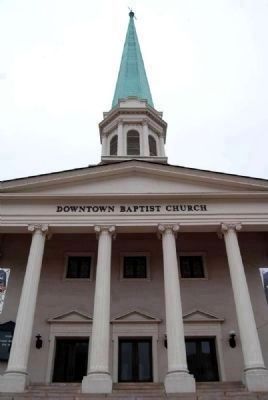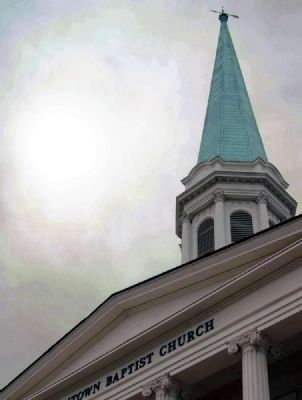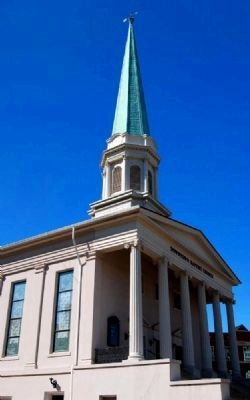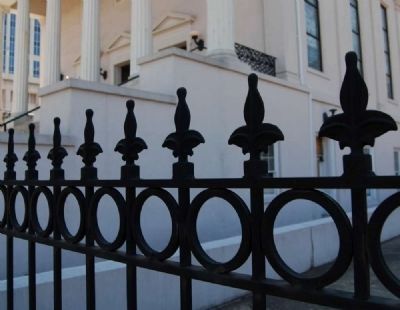Greenville in Greenville County, South Carolina — The American South (South Atlantic)
Downtown Baptist Church
Placed on the National Register
of Historic Places August 1977
Sanctuary designed by
Samuel Sloan of Philadelphia
Erected in 1857 and Dedicated February 21, 1858
Topics. This historical marker is listed in this topic list: Churches & Religion. A significant historical date for this entry is February 21, 1898.
Location. 34° 51′ N, 82° 24.067′ W. Marker is in Greenville, South Carolina, in Greenville County. Marker is at the intersection of West McBee Avenue and Richardson Street, on the left when traveling west on West McBee Avenue. Touch for map. Marker is at or near this postal address: 101 West McBee Avenue, Greenville SC 29601, United States of America. Touch for directions.
Other nearby markers. At least 8 other markers are within walking distance of this marker. Greenville County Courthouse / The Willie Earle Lynching Trial (about 400 feet away, measured in a direct line); South Carolina's First National Bank (about 500 feet away); Carolina Supply Company (about 500 feet away); Joel Roberts Poinsett (about 500 feet away); a different marker also named South Carolina's First National Bank (about 500 feet away); Poinsett's Spring (about 600 feet away); Stradley and Barr Dry Goods Store (about 600 feet away); a different marker also named Joel Roberts Poinsett (about 600 feet away). Touch for a list and map of all markers in Greenville.
Regarding Downtown Baptist Church. The history listed about "Downtown" Baptist Church is actually that of the congregation of First Baptist Church up until the move to Cleveland Street in the 70's when the old building was taken over by the new congregation calling itself Downtown Baptist Church (est. 1974). The old building downtown has again changed hands and is now used as the city home of Grace Church - Downtown.
Also see . . .
1. Downtown Baptist Church. Official website of the Downtown Baptist Church, Greenville, SC. (Submitted on April 3, 2009, by Brian Scott of Anderson, South Carolina.)
2. Downtown Baptist Church. For many years Greenville has been a stronghold of the Baptist denomination in the state, and the Downtown Baptist Church has been one of the focal points of that strength. (Submitted on April 3, 2009, by Brian Scott of Anderson, South Carolina.)
3. First Baptist Church of Greenville, SC. Information, worship, and activities from this Southern Baptist congregation affiliated with the Cooperative Baptist Fellowship. (Submitted on April 3, 2009, by Brian Scott of Anderson, South Carolina.)
4. Samuel Sloan. Samuel Sloan (1815 – 1884 in Raleigh, North Carolina) was a leading Philadelphia-based architect and writer of architecture books in the mid-19th century. (Submitted on April 3, 2009, by Brian Scott of Anderson, South Carolina.)
Additional commentary.
1. Downtown Baptist Church
For many years Greenville, South Carolina has been a stronghold of the Baptist denomination in the state, and Greenville's Downtown Baptist Church has been one of the focal points of that strength. Organized in 1831 with ten members, the church by 1930 had become "by far the largest church in Greenville County..." Still maintaining an active congregation, Downtown Baptist Church is one of the very few mid-19th Century public structures remaining in Greenville.
In 1851, Furman University, a Baptist denominational school, was established in Greenville, strengthening the church, as well as making new demands upon it. In 1852 James C. Furman, later president of the school and son of Richard Furman for whom it was named, wrote: "I wish the Baptists of the state would show the same wisdom which the Episcopalians of the low country do in putting up attractive buildings in important places in the up country...Our building which is larger than theirs scarcely contains our congregation. We have had to put down a double row of chairs on the aisles. In my means were such as to allow be subscribing liberally, I would urge upon our people the erection of another building."
In 1854, a building committee was formed to study the possibility of a new church. The prominent architect Samuel Sloan was employed, and in 1858 the present structure was completed.
The following year the strength of the Baptist church in Greenville was further evidenced by the opening of the Southern Baptist Theological Seminary in Greenville where it remained until 1877. (The meeting which resulted in the establishment of the seminary in Greenville was held in May 1858, at Downtown Baptist Church, and the seminary's first home was the old meeting house of the church.)
In the years that followed, Downtown Baptist Church grew steadily. In 1882, the church hosted the Southern Baptist Convention, and by 1889 it had held eight sessions of the State Convention. in 1890, the name of the church was changed from Greenville Baptist to First Baptist Church.
During the 20th Century the church continued to grow, and by 1956 the congregation numbered more than 2,500. During these years significant additions were made to the church, expanding Sunday School and office space; but by the 1970s many in the congregation felt the need for a larger building. At that time a majority of the congregation moved into a new building, taking the name of First Baptist with them. A sufficiently large group chose to remain in the older structure, and in 1974 they organized as Downtown Baptist Church. Today Downtown Baptist has an active congregation and is one of the few mid-19th Century public structures remaining in downtown Greenville.
Exterior: Downtown Baptist Church is a large Greek revival structure located in downtown Greenville, South Carolina. Constructed in 1858, it was designed by Samuel Sloan, noted architect of the mid-to-late 19th Century.
Set upon a high raised basement, Downtown Baptist Church features six Ionic columns supporting a pediment and tall central spire. It is constructed of brick covered with stucco. Numerous concrete steps lead to the portico which has three double glass entrance doors, each capped by a pediment. Above each entrance way is a window with vertical mullion. On the basement level there are 8/8 windows and an entrance way (all of which are parallel to the main floor window).
Alterations were made on all three of these facades ca. 1915. As shown by the architect's drawing and an early photograph, there was originally one front door, while the side windows were probably shuttered and included sixteen lights per sash. The stairway has also been widened one bay on each side.
Ca. 1914 a Sunday School building was added to the rear of the church. In 1940 this building was remodeled and an auxiliary building was erected. In 1950 a three story structure was added. In 1956 church growth again required new educational facilities, and construction began on another addition which was completed ca. 1957.
Interior: The interior features a central row of pews with one smaller row on each side. Balconies featuring recessed panels and supported by metal columns extend along the side and rear.
The basic plan of the interior has been maintained with the exception of changes made in 1915. At that time the sanctuary was enlarged approximately seventeen feet, the floor was made to slope, and the original two rows of pews were replaced by three. The pulpit area was changed and enlarged with the addition of an organ lost and choir gallery. During this remodeling the original perspective-painted architectural features (including Corinthian columns and stenciled cornice) were removed. Nevertheless, despite these alterations, the basic design of the decorative elements was maintained.
Architecture: Designer of the church was Samuel Sloan (1815-1884), who, according to the Dictionary of American Architects, was "one of the most distinguished of early American architects..."
Downtown Baptist Church has been altered on both the interior and exterior since its completion in 1858. Additions have also been made to the rear of the building. According to Harold N. Cooledge, professor of architecture at Clemson University who wrote his doctoral dissertation on Sloan, "...the additions to the original building have not destroyed Sloan's design nor inured its front appearance in any major degree...Hence, the present church building is one of the few early Sloan works which still stands in a reasonably original condition." (Source: National Register nomination form.)
— Submitted June 30, 2009, by Brian Scott of Anderson, South Carolina.
Credits. This page was last revised on December 13, 2019. It was originally submitted on April 3, 2009, by Brian Scott of Anderson, South Carolina. This page has been viewed 2,041 times since then and 35 times this year. Last updated on November 5, 2010. Photos: 1, 2, 3, 4, 5. submitted on April 3, 2009, by Brian Scott of Anderson, South Carolina. 6, 7. submitted on April 3, 2010, by Brian Scott of Anderson, South Carolina. • Craig Swain was the editor who published this page.
